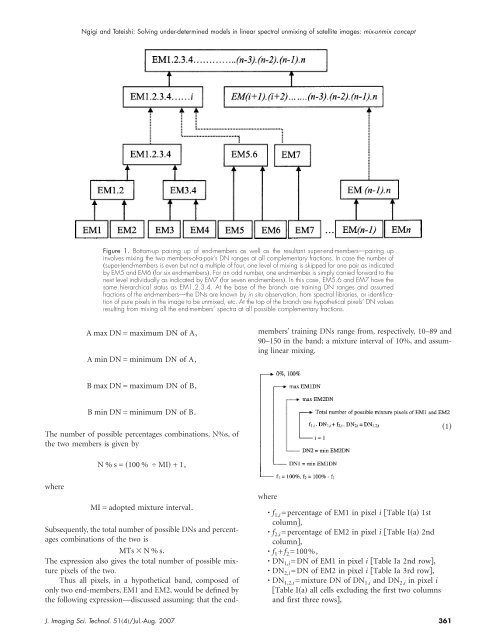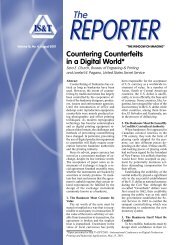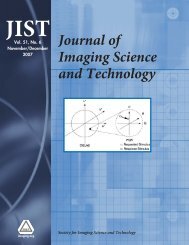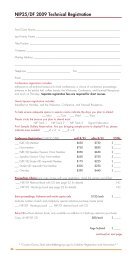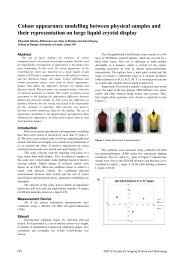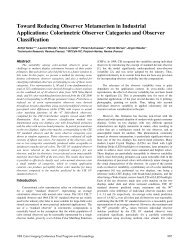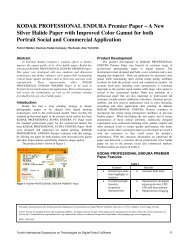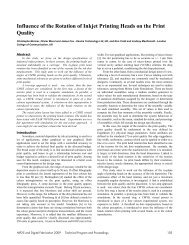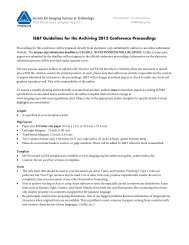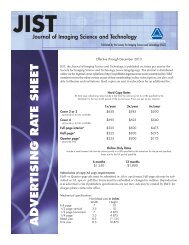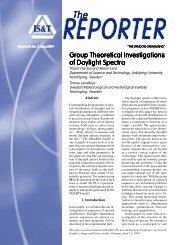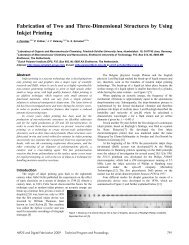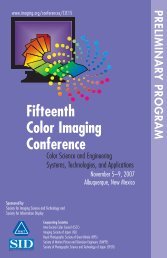Additional Material, Journal of Imaging Science - Society for Imaging ...
Additional Material, Journal of Imaging Science - Society for Imaging ...
Additional Material, Journal of Imaging Science - Society for Imaging ...
You also want an ePaper? Increase the reach of your titles
YUMPU automatically turns print PDFs into web optimized ePapers that Google loves.
Ngigi and Tateishi: Solving under-determined models in linear spectral unmixing <strong>of</strong> satellite images: mix-unmix concept<br />
Figure 1. Bottom-up pairing up <strong>of</strong> end-members as well as the resultant super-end-members—pairing up<br />
involves mixing the two members-<strong>of</strong>-a-pair’s DN ranges at all complementary fractions. In case the number <strong>of</strong><br />
super-end-members is even but not a multiple <strong>of</strong> four, one level <strong>of</strong> mixing is skipped <strong>for</strong> one pair as indicated<br />
by EM5 and EM6 <strong>for</strong> six end-members. For an odd number, one end-member is simply carried <strong>for</strong>ward to the<br />
next level individually as indicated by EM7 <strong>for</strong> seven end-members. In this case, EM5.6 and EM7 have the<br />
same hierarchical status as EM1.2.3.4. At the base <strong>of</strong> the branch are training DN ranges and assumed<br />
fractions <strong>of</strong> the end-members—the DNs are known by in situ observation, from spectral libraries, or identification<br />
<strong>of</strong> pure pixels in the image to be unmixed, etc. At the top <strong>of</strong> the branch are hypothetical pixels’ DN values<br />
resulting from mixing all the end-members’ spectra at all possible complementary fractions.<br />
A max DN = maximum DN <strong>of</strong> A,<br />
A min DN = minimum DN <strong>of</strong> A,<br />
Subsequently, the total number <strong>of</strong> possible DNs and percentages<br />
combinations <strong>of</strong> the two is<br />
MTs N%s.<br />
The expression also gives the total number <strong>of</strong> possible mixture<br />
pixels <strong>of</strong> the two.<br />
Thus all pixels, in a hypothetical band, composed <strong>of</strong><br />
only two end-members, EM1 and EM2, would be defined by<br />
the following expression—discussed assuming: that the endmembers’<br />
training DNs range from, respectively, 10–89 and<br />
90–150 in the band; a mixture interval <strong>of</strong> 10%, and assuming<br />
linear mixing.<br />
B max DN = maximum DN <strong>of</strong> B,<br />
B min DN = minimum DN <strong>of</strong> B.<br />
The number <strong>of</strong> possible percentages combinations, N%s, <strong>of</strong><br />
the two members is given by<br />
1<br />
N%s=100 % ÷ MI +1,<br />
where<br />
MI = adopted mixture interval.<br />
where<br />
• f 1,i =percentage <strong>of</strong> EM1 in pixel i Table Ia 1st<br />
column,<br />
• f 2,i =percentage <strong>of</strong> EM2 in pixel i Table Ia 2nd<br />
column,<br />
• f 1 +f 2 =100%,<br />
• DN 1,i =DN <strong>of</strong> EM1 in pixel i Table Ia 2nd row,<br />
• DN 2,i =DN <strong>of</strong> EM2 in pixel i Table Ia 3rd row,<br />
• DN 1,2,i =mixture DN <strong>of</strong> DN 1,i and DN 2,i in pixel i<br />
Table Ia all cells excluding the first two columns<br />
and first three rows,<br />
J. <strong>Imaging</strong> Sci. Technol. 514/Jul.-Aug. 2007 361


